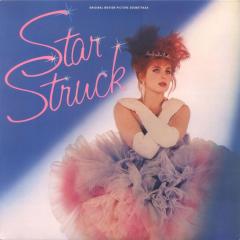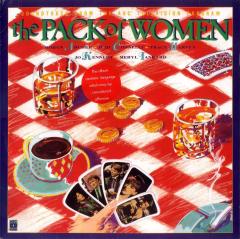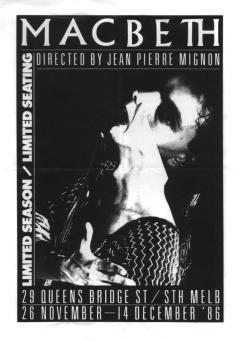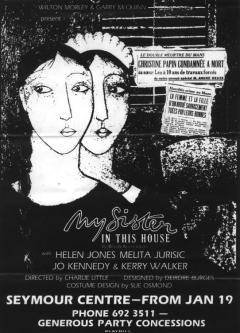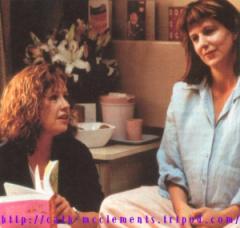The Cosmic Forces, Cast Member:
Jo Kennedy
|
Jo Kennedy is the internationally known actress/director.
She literally burst upon the scene in the Australian movie musical Starstruck (1982). Jo starred as Jackie Mullens who will do almost anything to become a star and puts on a show to help save the family pub from being closed down. She sings several songs: "Temper Temper," "It's Not Enough," "Tough," "My Belief In You," "Monkey In Me" and "Body and Soul" (which enjoyed some success as a single).
(It should also be noted that [a very young] Geoffrey Rush has a small part in the film playing a Floor Manager.)
This was director's Gillian Armstrong's second film and the very first to be produced Down Under in Dolby stereo. But Australia didn't have all of the necessary Dolby equipment, so post production was completed in Los Angeles. While there, the producers arranged for the first public screening to be a sneak preview at the Los Angeles Film Festival, Filmex (not to be confused with the Australian Film Industry Expo) on Wednesday, March 24, 1982.
Reaction in the United States and throughout the world was very positive--especially to Jo Kennedy's performance. She demonstrated terrific range under the most difficult of situations. But the film was received poorly at home since Starstruck was essentially a postcard view of Australia and was of little interest to those who live there.
But the feature did have a pronounced affect on future aussie filmmakers, with references popping up in such movies as Muriel's Wedding, Strictly Ballroom and The Adventures of Priscilla, Queen of the Desert.
And in one (expensive) 35mm theatrical short produced a few years after Starstruck, Jo (as directed) practically reprises the Jackie Mullens character in a small part. The production had even outfitted her in almost the same tutu from the musical.
Visitors to the Harbour View Hotel in Sydney (where some of the exteriors were filmed) are usually disappointed to discover that the interior has been remodelled. The truth is that the interiors never looked like what you see in the film. For the film, the production company designed its own pub set and built it in a warehouse.
Immediately following the feature, Ms. Kennedy received a slew of offers and agreed to appear in a cinema verite TV episode being produced by writer/director Phillip Noyce. The episode, Survival (1982), was part of a series of 50 minute films being hosted by television presenter and interviewer, Mike Willesee. The intriguing concept behind this episode was to film the real life exploits of 4 people left on a deserted island off the North Queensland coast for 7 days. The 4 people were Jo Kennedy, fellow actress Diane Cilento, Michael Willesee and a woman doctor.
(Today "cinema verite TV" is called "reality television" and the concept seems remarkably similar to the series, Survivor.)
Nothing went to plan during filming. The cast, in search of water, tried to suck (what turned out to be) the poisonous juice out of a native palm tree. Using an emergency radio, the cast discovered that the island wasn't deserted at all and set out on foot to eventually find settlers on the other side of the island.
The episode, notorious in the Australian television industry, is completely unavailable and appears to have been erased from history and from the minds of all its participants (though some viewers still remember the image of Jo Kennedy [making a comment on consumerism by] repeatedly trying to swipe a credit card into a palm tree). There is a brief mention of the episode in Ingo Petzke's biography of Phillip Noyce, "Backroads To Hollywood."
Next, came something a little more civilized, a play (Kennedy had been classicly trained at the National Institue of Dramatic Arts). She appeared in The Kid at the Nimrod Theater (in Surry Hills) which was probably the most dynamic, influential legit company in Australia at the time. (Today it's called the Belvoir Street Theatre and it carries on in the same tradition.)
Written by Michael Gow, the play is an coming of age story about a group of kids who travel to the city to seek financial restitution for their brother who has been hit by a bus.
Ironically, after this play, Jo returned to the cinema but as a character (Zenobie) in a stage play. The movie, The Boy Who Had Everything (1984) was directed and written by Stephen Wallace. Jason Connery (Sean Connery's son) starred with his real life mother, Diane Cilento, playing his mother in the film. (Diane and Jo had worked together before in the aforementioned Survival.) In a supporting role (as Graham Cummerford) was Nique Needles who would later co-star with Jo in their own feature.
Back to the theatre, Ms. Kennedy performed in the second production of Slow Love (1985) which was presented at the Performance Space (199 Cleveland Street) in Redfern. The play was written by Richard Murphett and today has been called, "...an Australian avant-garde classic." It does not have a traditional plot. Instead of a book there are only stage instructions with very little dialogue. What is called for are 187 short scenes (blackouts), with 2 men and 2 women, who through their actions make comment on romance, love and eroticism. But a story does develop as relationships develop and intertwine.
All this plays with our idea of cinematic love. The blackouts and the permutation of scenes can conjure up a film noir--with later day reviewers noticing similarities with the feature, Groundhog Day (1993).
A great deal of physical training is needed to participate in the production. (And it's definitely a lighting board operator's heart attack).
The feature, Wrong World (1985), was directed by Ian Pringle, with Ray Argall as the director of photography and editor. Jo's brother, Chris Kennedy, was the assistant art director. This would mark the first of several productions in which Ray and/or Chris would work with Jo.
Richard Moir stars as David Trueman, a doctor who is disillusioned with the world and becomes addicted to morphine. He meets a fellow addict, Mary (Jo Kennedy), and together they still face all of the problems which drug addicts have but love still seeps through anyway. At least they suffer together. It's all very depressing but ultimately rewarding and never cliche. For her performance, Jo won the Silver Bear for "Best Actress" at the 1985 Berlin Film Festival.
Her next role came in the limited television thriller, Pokerface (1986). Bruno Lawrence starred as Crawley, a journalist who ends up working for a security agency and gets involved with Roxy (Jo Kennedy), a drug addicted artist.
Three 50 minute episodes were produced for the Australian Broadcasting Corporation (ABC). The first episode aired October 9, 1986; the last aired October 23, 1986. Richard Sarell (of Neighbors fame) directed; Bill Garner and Peter Corris wrote the teleplays.
They must have liked her over at the ABC as Jo's next part came in the musical special The Pack of Women (1986).
Created by Robyn Archer as a cabaret, The Pack of Women features 5 female leads (Robyn herself being one of them), singing and acting out scenes of the choices, conflicts and restrictions facing modern women. The troupe takes turns performing songs solo or together but Jo performed lead vocals on, "Waiting Too Long," "In Business," "(S)he's A Rebel," "Dig Deeper" and "Is That Me?" (which was released as a single). The TV special won the ARIA soundtrack of the year for 1986. The songs and Jo's singing are excellent but unfortunately the soundtrack has never been re-released.
Jean-Pierre Mignon (who had directed the first production of Slow Love) was now mounting the Australian Noveau Theater's own take on William Shakespeare's Macbeth (1986). They were to perform the drama in an abandoned industrial warehouse with a minimum of sets; thespians would play as many different parts as possible--just as an acting troupe would (but not as a gimmick). Costumes, lighting and props would be detailed so it would not appear to be a bare-boned, budgetless production. The idea was to focus attention on the drama.
Playing the lead was Robert Menzies, while Jo Kennedy played Lady Macduff, Witch 3, a Gentlewoman and (unbilled) a soldier. Menzies and Kennedy had always wanted to work together and this was the first of several collaborations.
Back to New South Wales, she next appeared in the Sydney Theatre Co.'s production of Cuckoo's Country which concerned poetry.
The Sydney Theatre Company is probably the best known theater group in Australia by virtue of being the resident company of the drama theatre in the Sydney Opera House. Just about every Australian's pilgrimage to Sydney must include 2 stops: #1. Getting drunk in The Rocks; #2. Going inside the Opera House. But most of the innovative productions are staged in 2 theatres (Wharf 1 and Wharf 2) on Walsh Bay which is where Cuckoo's Country was performed.
Another requirement seems to be that every school child must watch Michael Willesee's Australians (1987/8). (Willesee and Kennedy had worked together in the aforementioned Survival.) Originally broadcast on the Nine Network, this limited series of 13 one hour episodes (they actually run 48 minutes without the commercials) concerned historically important (but not necessarily famous) Australians. Each episode concerned a different individual.
Ms. Kennedy appears in the "Vivian Bullwinkel" episode. Rachel Ward starred as Vivian Bullwinkel, a volunteer nurse during World War II who escaped via ship from the Japanese invasion of Singapore. She ended up in a Prisoner Of War camp with other nurses on the island of Banka. If it sounds familiar, it should; her story partly inspired the Bruce Beresford feature, Paradise Road (1997).
The episode was directed by Rod Hardy and written by Anne Brooksbank; Barry Quin co-starred in the Roadshow, Coote and Carol production.
At the Seymour Centre in Sydney, Jo co-starred in the play, My Sister In This House (1988). Based on the true story of the two French chambermiads (the Papin sisters) who murdered their employers, the play was written by the American playwright, Wendy Kesselman. It was first performed at the 1981 Humana Festival by the Actors Theatre of Louisville, Kentucky. Later, it was adapted as the U.K. feature, Sister My Sister (1994). An entirely different version (not based on the play) was produced in France entitled, Les Blessures Assassines (2000) and released in some countries as Murderous Maids.
A convergence of sorts occurred on Tender Hooks (1989) as a number of individuals in Jo Kennedy's world all worked on this one feature. She starred as Mitch, Nique Needles co-starred as Rex, Robert Menzies had a supporting role as Yawn and Ray Argall was the director of photography. New to the group was director/writer Mary Callaghan, who had scored a major hit a few years earlier with her short, Greetings From Wollongong (1982).
A slacker movie ahead of its time (Richard Linklater's Slacker [1991] would not come out for another 2 years), it's a comedy about a hairdresser (Jo) who falls in love with a guy (Nique) who may or may not turn out to be (in true ozzie tradition) a criminal.
The film barely got a release within Australia and even less overseas. It could use some re-evaluation now that it can be put into perspective. It's not a great film (and for some, not even a good film) but it may represent a turning point in dramatic narrative cinema. The film industry seemed to recognize it, as Jo Kennedy was nominated for Best Actress for the 1988 Australian Film Institute (AFI) Awards. (The film was not released until 1989.)
Jo then had a bit part as the character "Paradise" in the feature, Golden Braid (1990). Based on the 19th century short story, "La Chevelure" by Guy de Maupassant, this contemporary film concerns, "...a man's obsession with a lock of golden hair he finds hidden in a secret compartment of an antique cabinet." The lock of hair becomes his link to the past.
The prolific, Dutch-born, aussie fixture, Paul Cox directed and co-wrote. Paul has found Australia to be a financial heaven for raising money for his movies. He's been able to direct a feature almost every year since 1976. Chris Haywood starred, Robert Menzies has a small part and the director shows up as a priest.
By coincidence, Kennedy's next role came in the television series Boys From The Bush (1991-1992) which again starred Chris Haywood (and Tim Healy). The two stars played partners of a very unsuccessful detective agency called "Melbourne Confidential" but the stories actually concerned their love/hate relationship with Australia and England.
This one hour dramedy (executive produced by Fred Schepisi) was originally developed by BBC-TV 1. The Australian Seven Network became co-producer when it paid for domestic transmission rights but then refused to air the first season of 10 episodes. The series actually premiered in the UK with Jo Kennedy appearing in two episodes, "Creepy Crawlies" (episode 5) on February 22, 1991 and "Bucks and Hens" (episode 6) on March 1, 1991. A second, final season of 10 episodes was produced.
Boys From The Bush (and its most unusal pedigree) was the subject of one of the chapters in "Australian Popular Culture" published by the Cambridge University Press and edited by Ian Craven. Sections of this book are a must read for anyone interested in the Australian television business.
Phoenix (1992-1993) was an ABC television series on the specialists of the "Major Crime Squad" who must legally apprehend violent criminals. Created by Tony McDonald and Alison Nisselle, each season concentrated on just one story, with a total of 13 one hour episodes per season.
The first season concerned a group of cop killers who plan to bomb a police station. Jo Kennedy played the role of Elaine Henderson, a mom who lives right next door to a potentially explosive finale. She appeared in the final 2 episodes of the season; the 12th, "Paradise Tomorrow" (broadcast April 23, 1992) and the 13th "Hardball" (broadcast April 30, 1992). The first season was critically acclaimed; the second season did not go as well. A spin-off, Janus (1994), followed.
Jo then took the next few years off to become a mum. During this time she decided to make a career change. She had always been interested in writing and directing and now she would add that to her career. She would still be an actress but now also a filmmaker.
She enrolled at the University of Melbourne, College of the Arts (sometimes called Victoria College of the Arts), School of Film and Television, Director's course.
Her first short film as a director was Roast (1997), which was so good that it was added to the Australian Film Institute's collection. Her second short (with a delightful, unexpected twist ending), Quill (1997), was shown at the American Cinematheque "Down Under Shorts" program on Wednesday, June 23, 1999.
Her third short would be her longest yet. Her screenplay won the university's AAV Australia - C. Robert Fine Memorial Scholarship of 1997 (for best script by a "Graduate Diploma Student"). Jo's brother, Chris, signed on as production designer with Ray Argall as director of photography. She was also able to add Helen Morse (in a supporting on-screen role) to the package. Morse had been mostly performing theater at the time and is probably best known for her film roles as Mlle. de Poitiers in Picnic At Hanging Rock, Evelyn Crawley in Agatha and Jean Paget in A Town Like Alice.
Jo would finally get to shoot The Bridge (1997) in Warburton, Victoria (where she grew up) in August in the winter of 1997. Of Warburton, she said, "Growing up in a small town I felt the isolation strongly. As a teenager I would sit on the weetbix factory wall watching the cars pass through on their way to the city wishing it was me going there. 'The Bridge' is about that yearning."
The short was her most realized film yet. The Bridge is all about the tyranny and isolation of small towns everywhere and how family can be a prison. It won "Best Achievement in Direction" in her graduating class, was invited to compete at Clermont Ferrand Festival in France and then presented at Cannes as part of the forum screenings.
Returning to acting, Kennedy appeared in the very first episode of Stingers (1998-2004), the long running television series on the Nine Network. The series involved undercover cops who, each week, infiltrated a different gang or criminal organization. One of the series regulars was Anita Hegh, who would later star in Jo's first, short feature.
The episode, "Ratcatcher," premiered on September 29, 1998 with Jo Kennedy playing Karen Gallagher, a member of a sinister, criminal family. The Canadian premiere was on the Showcase Action network in September, 2001 with a UK premiere on the Granada Plus network on August 4, 2004. The series was produced by Roger Le Mesurier, John Wild and Roger Simpson (who created the show).
Starting in 1999 and continuing off and on until January of 2001, Jo recorded (in Los Angeles) her co-starring role in the radio drama series, The Soul Patrol. Although she had toured America before as part of the publicity for Starstruck (and had even visited The White House) this was the first time she had performed in that country.
The part of Billi St. Kilda was written expressly for her. The character name was no accident. "Billi" is what aussies call a tea kettle and "St. Kilda" is the colorful city outside of Melbourne which bests reflects the character. "Billi" also follows the long standing aussie tradition that the leading female character have a slang (almost) male name. As example, Jo's starring roles include: Jackie, in Starstruck and Mitch, in Tender Hooks. ("Billi" is also in tribute to her real name: Jo!)
Inbetween recordings and trips around the world was the television movie, Waiting At The Royal (2000) for the Nine Network. "The Royal" refers to the Royal Hospital in Sydney. The story concerns four women with difficult pregnancies who temporarily live together in the same room of the hospital. Their characters have no escape, no real privacy and are faced with dilemmas beyond childbirth. One of the four is Diana (Jo Kennedy), a lesbian who's pregnant with twins. Her once stable relationship with her "significant other," Eloise (Noni Hazlehurst), takes an unexpected turn for the worse.
Written and directed by Glenda Hambly, it was Hambly's first TV movie after a long career in series (and one feature). Broadcast on Sunday, August 13, 2000, it was the second highest rated TV movie of the year in Sydney & Melbourne receiving a whopping 21.1 rating. Jo was nominated for the second time by the AFI, this time for "Best Performance by an Actress in a Telefeature or Miniseries" (in 2000) but the award went to fellow cast member Noni Hazelhurst. Waiting At The Royal went on to win the Rockie Award for "Best Made-for-TV-Movie" at the 2001 Banff Television Festival. It was subsequently played on the Canadian Women's Television Network (WTN) on Monday, March 18, 2002.
During this same time, Jo was working on her new short, Lost (2000). Returning again were actress Helen Morse, Chris Kennedy as art director, director of photography and co-editor Ray Argall. Joining the fold were co-producers Clare Sawyer & Roslyn Walker. Production had finished before Waiting At The Royal had even started. (The music cues and rights took longer than expected.) Once completed, it premiered at the American Cinematheque's "Down Under Shorts" screening on Tuesday, June 20, 2000.
Only 13 minutes long (it feels much longer for all the right reasons), the fictional film provides a supernatural explanation for the 3 missing Beaumont children, an infamous, 1966 case that still resonates strongly in Australia today. In most Western countries when there is a child missing, criminal behavior is usually suspected; but in Australia the immediate suspicion is of having been overwhelmed by nature, the outback or other likewise causes. And for all of this (and more) it won the Cinemedia Erwin Rado Award for Best Australian Short Film at the 38th International Short Film Competition within the 49th Melbourne International Film Festival in 2001 and the Silver Leopard at the Locarno Film Festival in Italy.
The closing feature for that same Melbourne festival was the Australian Premiere of Mallboy (2001). Kane McNay stars as Shaun, a 14 year old from a broken home trying to reconnect with his father who has just been released from prison.
Directed and written by Vincent Giarrusso, a musician, this was his first feature. The press package reported, "Vincent had a director's workshop with dramaturg Jo Kennedy who took him through various techniques of working with actors. 'We'd do some exercises to warm up and them a lot of it was improvisation. I'd put the actors into a situation, and let them go, for an hour, or as long as it took, just to build up their relationships,' says Vincent." Jo also did a bit part as the character, Janice.
The feature was included in the Director's Fortnight series at Cannes in 2000 (before being shown in Melbourne). It had its broadcast premiere on the Special Broadcasting Service of Australia (the SBS network) on September 2, 2003.
(Even though this concludes her biography up to the recording period of The Soul Patrol we'll go just a bit further.)
With her success with child and teenage actors (for her own short film and then a feature) Jo then got work on two, half hour children's series back to back.
First was Short Cuts (2002) a 26 episode series for the Seven Network. Premiering on April 6, 2002, the show was about 9 media students who are given Digital Video Cameras (DVC) to make short films each week. Kennedy was one of several "DVC unit directors" who would direct the video footage supposedly shot by the students. The Executive Producer was Ewan Burnett, the Producer was Margot McDonald and all of the episodes were written by Marieke Hardy. In 2002 the program won the AFI award for Best Children's TV series and Marieke Hardy won the AWGIE (Australian Writer's Guild Award) for Best Original Children's Series.
Next, Jo returned to drama coaching for Worst Best Friends (2002). The title addresses the intriguing premise that the central character, an 11 year old boy, has two best friends who hate one another. 13 episodes were produced by CoxKnight Productions for Network Ten and were broadcast in the summer (starting in November 2002 and concluding in February 2003).
With the success of her short film, Lost, Ms. Kennedy was able to receive funding for her next production from the Australian Film Commission (AFC), Film Victoria and ABC Television. The AFC had created a new program called, "50 Minutes From Home," for which they would provide (and help find additional) financial backing for a series of (approximately) 50 minute short features which could be broadcast as TV one hours and (with the Special Broadcasting Service Independent program [SBSi]) present them as quickie double bills in cinemas.
Jo's short feature, The Forest (2003) was her longest and most personal film yet. At 51 minutes long, it's about a wife, Ashley (Anita Hegh), who has a disturbing dream but for some reason her husband, Ben (Tony Martin) doesn't want to talk about it at their tenth wedding anniversary and claims that he has a work commitment. Ashley suspects that Ben maybe lying to her and so she investigates the situation.
The screenplay was co-written by associate producer, Christine Rogers (who wrote the kiwi short, Honey [2000]). Clare Sawyer produced, Robyn Kershaw was the executive producer for the ABC which has the licensing rights. The film premiered at the Sydney Film Festival in 2003 as part of the Seven Little Australians program and was then presented at the Melbourne International Film Festival as part of the Australian Showcase series and at the Telluride Film Festival in the United States.
The Forest was part of the "50 Minutes From Home" Film Festival which traveled to all the major cities of Australia from September 10 to October 26, 2003. The short feature then had an exclusive engagement for one week (March 11 to March 17, 2004) at the George Cinemas in St. Kilda, Victoria.
As of this writing, Jo Kennedy is developing her first feature film, Unlocked, a psychological thriller.
Further Viewing...
YouTube - Starstruck Trailer.
YouTube - Starstruck "Starstruck" Music Video (Jo Kennedy appears only at the very end).
YouTube - Starstruck "Gimme Love" (cropped to 1.85).
YouTube - Starstruck "Body & Soul" (low resolution but almost the correct aspect ratio of 2.35).
YouTube - Starstruck "Body & Soul" (a slightly different version of the above).
YouTube - Starstruck "Body & Soul" (with the sides cropped to 1.33 and has a countdown opening "1, 2, 3, 4" not in the film).
YouTube - Starstruck "Temper Temper".
YouTube - Starstruck "Tough".
YouTube - Starstruck "Monkey In Me".
YouTube - The Director's Series Part 1 of John Gallagher's 1983 Interview with Starstruck director, Gillian Armstrong.
YouTube - The Director's Series Part 2 of John Gallagher's 1983 Interview with Starstruck director, Gillian Armstrong.
YouTube - The Pack of Women "Is That Me?"
